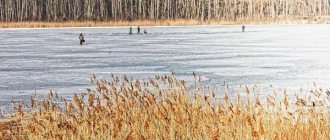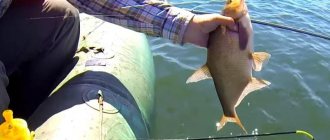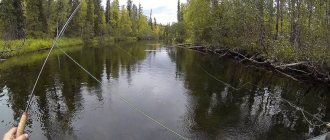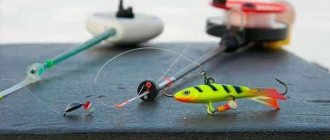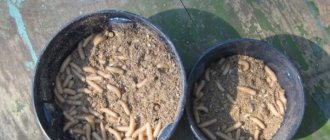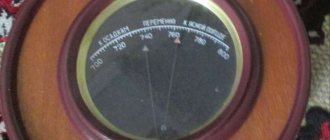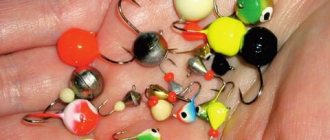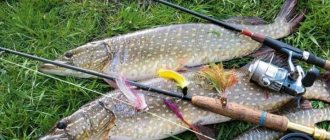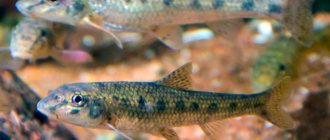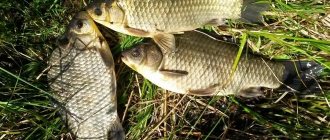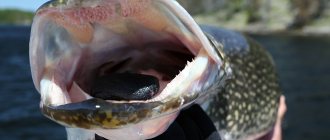Cloudflare Ray ID: 63a9bd0a7d9c8ddb • Your IP: 195.64.208.251 • Performance & security by Cloudflare
Perch is often found in water bodies in the middle zone; this fish is highly active. The predator is greedy and omnivorous. It actively reacts to different baits, but the bite depends on the time and fishing conditions. The result of fishing is influenced by the availability of gear; weather conditions are of great importance. Let's figure out what weather the perch bites best in winter.
Does atmospheric pressure affect fish activity?
Weather is of great importance for perch fishing; stable atmospheric pressure contributes to perch biting. It is best to fish near the places where it will spend the winter; pressure is of great importance for perch. In winter, you need to look for perch in the deepest places, where he spends all his time.
Perch is a fastidious fish that does not like sudden changes in weather conditions. The fisherman should know that the predator bites well at stable atmospheric pressure. The fish feed actively when the weather gets warmer. At the end of winter, the bite becomes more active if the wind blows from the west or air masses come from the south.
When pressure levels are stable, the predator is actively hunting. It chases small fish and attacks baits and lures.
Low
When pressure levels are stable, perch gather in schools. The fish senses the change in weather well; with a gradual decrease in pressure, the bite intensifies, and perch is caught well. In late autumn at this time there are clouds in the sky and it is drizzling. In winter, clouds gather. The time before snowfall can be used to catch perch.
High
Fishermen should take advantage of the opportunity to catch perch on a frosty day with high atmospheric pressure, but they should pay attention to the fact that it must be stable. At high pressure, fish rise to the upper layers of water and actively hunt under the ice.
Increased pressure forces the perch to go into shallow water; it swallows bait in a layer of water from 50 cm and below. The predator reacts to jigs and spinners. In order for fishing to be effective, you should move between holes, stepping as quietly as possible. The best way to avoid noise is to properly lay out your tackle at the hole.
There is no need to remove the sludge from the drilled hole. After forming a hole in the ice, you should wait at least 5 minutes, this is necessary for the fish to calm down. After this, you can start fishing.
Sharp jumps
A sharp change in atmospheric pressure affects the perch bite. When the weather changes, the schools scatter and fish are difficult to catch. The biting may stop completely.
The most ideal option is stable average pressure. Good results occur with persistently low or persistently high pressure, and good results with slowly falling pressure (no more than 2 mm Hg per day). And this is typical for the entire period of open water (I don’t do winter fishing).
I have been fishing for perch with spinning rods for many years. I consider perch fishing to be very exciting and sporty. Over the entire period of my spinning practice, I have mastered the methods of catching striped fish with spinners, microjigs, retractable leashes, twitching, and topwaters.
I fish on my native river, where I grew up since childhood, on weekends and in the evenings after work. And always, when my catches were insignificant or equal to zero, I wondered: what influences the perch’s biting activity?
After much research, I came to the conclusion that the main criterion for assessing a good bite is pressure. In addition to pressure, many factors influence the bite. These are the temperature of water and air, the strength and direction of the wind, the phase of the moon, and so on. But the most important factor for a good bite is stable pressure.
Very useful information was the observations of underwater hunters, who told me that during sudden pressure surges, perch is in a passive state, as a rule, standing motionless alone at depth. The exception is the ubiquitous smallmouth bass. And indeed, it seems to me that small things tolerate pressure changes less painfully.
I am not interested in small perch, and therefore, when planning a fishing trip, I carefully monitor the barometer readings and periodically, with a light click of my finger on the glass of the device, I determine the amount of needle deflection. The more the pressure drops or rises, the more the arrow will deflect down or up, respectively, and therefore, the less chance there will be of catching a perch that day.
The most ideal option is stable average pressure. Good results occur with persistently low or persistently high pressure, and good results with slowly falling pressure (no more than 2 mm Hg per day). And this is typical for the entire period of open water (I don’t do winter fishing).
Thus, by using a barometer in perch hunting, I got rid of “idle” fishing. Good luck to all! Treat fish and people with respect!
Especially if it has dropped, after the weather had been stable with high atmospheric pressure for several days, the predators begin to really eat.
What to do if the perch doesn't bite
If there is no bite, you can use bait and bite enhancers . Or an active game if fishing takes place from the ice. Here, the fisherman’s ability to play with bait in an attractive manner from the point of view of the fish comes first. The more passive the perch behaves, the more persistent, careful and tolerant the fisherman should be. In this case, the fish must be caught by starvation and with suitable gear. But remember, this does not guarantee results. You need to practice, try and gain experience. The best solution would still be to wait for favorable weather.
Behavior of perch underwater, watch video:
Reasons why a perch may not bite
A perch may not bite for many reasons. These may be prevailing northern or eastern winds, anticyclones, increased atmospheric pressure, or cold snaps. A noticeable indicator of increased pressure is the disappearance of clouds, which is naturally accompanied by increased solar radiation activity. How all these mechanisms act on fish is not so important. It is important to know how they affect the bite. In this case - for the perch bite. Also, perch will not bite in places where there are no forage fish.
To learn to take into account all the weather nuances and little things, you need to practice your fishing skills more often. This way you can compare the described factors related to perch fishing much faster.
Influence of atmospheric pressure depending on the season
Spring bite
The most wonderful time for fishing is early spring, when the water temperature begins to rise, hungry predators, and most of the ichthyofauna are actively biting on any bait.
The bite may drop due to gusty winds, a sharp drop in temperature and strong pressure surges.
From mid-April, the fish become more picky and willingly bite in light winds and stable weather throughout the day. She is also reluctant to take bait in cloudy waters, which is associated with melting snow.
Summer bite
In summer, when the water rises to more than 25 degrees, the fish becomes apathetic, and its behavior is highly dependent on atmospheric pressure. Cloudy but windless days are considered optimal weather for fishing. The predator takes bait well on days with short thunderstorms.
It is best to go fishing either at dawn or at night, when the temperature is slightly lower than during the day.
Autumn bite
In the fall, as soon as the temperature drops, the fish begin to actively take the bait. For fishing in the autumn season, it is better to choose warm days with light winds.
Pike bite more actively in September on cloudy days, until the first cold, then the bite drops. But carp breeds have low activity in the fall.
Winter bite
In winter, most fish are very susceptible to pressure fluctuations. If it has changed up and down several times in a short period of time, you should not expect a good bite, even if it stabilizes. It needs to stay at the same level for 2-5 days, then there will be a bite.
Whether there will be a bite or not depends very much on the combination of ambient temperature and pressure. So, if in winter the barometer rises by 25-30 mm, and the thermometer drops by 7-12 degrees, you can’t expect a bite.
Also in winter there will be no bite if it drops by 9-11 mm and at the same time the temperature changes. The bite will resume only when these parameters stabilize.
The bite will be good if high pressure is combined with low air temperature, and low pressure will be on days of thaw and mild frosts.
To decide which pressure is best for fishing, you must first decide what you want to catch and then, depending on the season, choose the optimal days for fishing.
Whether it is necessary to struggle with difficulties depends on the perseverance of the fisherman himself. Let us repeat that the fish activity on such days is very decent. The direction of the wind, by the way, can also be quite important, but in different regions of our large country, the wind of the same direction can have both a minus and a plus sign.
We are already starting to get used to the long, drawn-out autumn and the lack of normal ice even in early December.
By the way, there was no point in waiting for an early winter this year in the Middle Zone. Remember the weather twenty years ago. In August it was already cold, and not everyone wanted to swim after Ilya’s day. There were frequent rains, at the end of the month the foliage on the trees began to turn yellow, and in September it was often possible to see frost in the mornings. By the end of September the first snow fell, which could easily not melt for two or three days. That’s when the ice stopped at the end of October, and on the November holidays they often opened the season on the largest body of water in the region - the Gorky Reservoir.
In general, with careful observation of nature, it is more difficult to make hasty and, as a rule, incorrect conclusions regarding the upcoming winter weather. But take this thought as a preamble to a detailed conversation about perch weather itself. After all, it is absolutely clear that on some days our main winter fish bite very well, and on others - just disgustingly.
So is it possible to avoid deliberate “overflights” without going to reservoirs on unfavorable days for biting? It seems to me that this is quite possible. Diary entries from the last ten years reveal some patterns in the behavior of the striped predator.
Let's arrange eight weather situations in descending order of perch activity: from very good fishing conditions to very bad.
1. Stable weather with slight frost of 5-10 degrees, stable average pressure, high clouds and lack of wind. I would call this weather ideal for perch fishing. Well, firstly, it is very comfortable for the fisherman to fish on such a day: neither frost, nor wind, nor precipitation interferes. And a comfortable existence also affects the results of fishing, no matter how strange it may seem at first glance. Secondly, the fish are active almost all day.
I’ll make a reservation: we are talking about the first half of winter, the period from the beginning of freeze-up until mid-late January, since in February and March several seasonal factors are recorded as negative, and even in good weather you may not catch anything. But in good weather at the beginning of winter, you can fish almost all day with varying success in one small spot; the perch will appear all the time. On such a day, the effectiveness of bites is also high - the perch takes the bait confidently, and gatherings are quite rare.
There is an opinion that perch is not afraid of noise. This opinion is only partly true. Firstly, it is not always afraid, secondly, as a rule, only small perch are not afraid, and thirdly, if we are talking about shallow fishing, then, most likely, even small ones will be “scared” for a while perch. In any case, there is no need to “pump” the hole; this can seriously alert the perch, and the angler’s patience in developing a new hole may end before the perch returns.
3. A clear frosty (15-25 degrees) day with stable high pressure and no clouds in the sky or wind. The activity of perch on such days is very high. The only pity is that she usually fits in two or three morning and one or two evening hours. Apparently, bright sunny weather increases the illumination of the underwater kingdom and makes it difficult for perch to hunt for fry.
Moreover, this applies not only to the first ice with 5-10 cm of ice, but also to the days of mid-winter, when the ice is thick, and there is also half a meter of snow on it. It seems that under such a “cap” the fish should not care whether the sun is shining or not, but in practice on a sunny day the catches are always smaller. This trend is especially clearly visible in the example of pike fishing, which on a bright sunny day may not go hunting at all. Perch is not a pike, of course, but it doesn’t really like the bright sun either.
4. Frosty (more than 15 degrees) day with strong wind. The objective factor - the activity of the perch - may be positive, but the subjective factor - the capabilities of the fisherman - may not allow for a good result. Remember the situation: the hole is constantly covered with ice, your hands are cold, the wind blows away both the “game” of the jig and the most careful bites of the fish. It seems to be biting, but there is no joy.
Whether it is necessary to struggle with difficulties depends on the perseverance of the fisherman himself. Let us repeat that the fish activity on such days is very decent. The direction of the wind, by the way, can also be quite important, but in different regions of our large country, the wind of the same direction can have both a minus and a plus sign.
5. Cloudy day with low atmospheric pressure and slight frost. On such a day, the perch clings to the ground and moves little. I caught one or two from the hole - and you can drill again, even if it’s two meters away, and again there is an opportunity to catch one or two fish.
In such weather, perch is reluctant to leave the ground and is difficult to catch with reelless jigs. Much better results can be achieved with a spinner, working with it strictly in one horizon. And the most abundant catch can be found when fishing with a jig with a nozzle. Moreover, sometimes no game is required at all: if you tap the jig on the bottom and put the fishing rod on the ice, the perch will take the stationary bait more confidently.
6. Thaw. Warm cloudy windless day. This weather is often called “raft” and “pike” in the middle zone. And indeed, pike, sorog, and sometimes rudd are very well caught during the winter thaws.
But sometimes perch can be caught. Even during the winter rain there were such successful fishing trips. And yet, in the thaw it is better to go for some other fish, and not for perch.
7. Snowfall. Blizzard. As a rule, they pass against the background of falling atmospheric pressure, indicating the passage of an atmospheric front. The weather is very difficult for perch fishing. There are, again, exceptions, but in 9 cases out of 10 in snowy, windy weather the perch is caught very poorly.
And if more negative factors are added (the release of water from a reservoir or the beginning of the dead winter period), you can immediately leave the ice. But this is if there is room for maneuver, that is, the opportunity to wait out bad weather and go out on the ice the next day. If this is not possible, you have to use your one chance out of ten. It's rare, but persistence is rewarded.
8. Breaking the weather. In the morning we went out - it was a little frosty, the sun was out, the fish were biting. But after a couple of hours a strong wind blew, the clouds rolled in, it became stuffy, and the perch “went on strike.” The worst situation. Most likely, the bite will not resume. And when the weather breaks, bites sometimes occur. But they are no longer widespread, but isolated, and few fishermen are satisfied with this pace of fishing.
As a rule, such weather disruptions are well predicted by weather forecasters, but not only by them. Older people begin to “twist their bones”, get headaches and feel tired. This effect of changing weather from good to bad apparently has not only on older people, but also on fish, since they are extremely poorly caught at this time.
But during the opposite situation, you can get into a good “distribution”. The whole day was neither this nor that, the bite was rather weak, and in the evening it began to feel noticeably cold, and the atmospheric pressure rose slightly. This is where the perch showed itself: it pecked continuously until the deepest twilight. So there's a difference between the two, as it turns out.
Of course, some days do not fit into the eight described schemes, but in general, a good perch bite will always be accompanied by: stable (or slightly increasing) average (or slightly increased) atmospheric pressure; lack of wind or weak wind; frost 5-12 degrees; high clouds or partly cloudy. It’s simply a sin to miss a winter day with such parameters, because there aren’t that many of them during the season.
To support my words, I will give an example from personal practice. A friend and I planned a trip to a suburban reservoir to catch a striped robber. The day before, having looked at the weather forecast, we were horrified - weather forecasters promised a hurricane north-west wind gusting up to 24 m/s, heavy precipitation in the form of sleet and a drop in atmospheric pressure from 732 to 710 mm Hg. st!
What weather is best to fish?
Ideal weather for fishing is a mediocre concept. Moreover, it is not so easy to guarantee comfortable weather conditions for each individual body of water.
On the other hand, fishermen who regularly fish for a particular type of fish have sufficient knowledge and experience to make a good catch in any weather.
In general, favorable fishing weather is reminiscent of mid-spring. The air temperature is not yet high, but the water is gradually starting to warm up. Crucian carp, silver carp, carp, tench, and roach are just becoming more active. And next to the potential food, predators, such as catfish or perch, are sure to swim. Representatives of the ichthyofauna bite on a regular fishing rod, while predators are hooked on a spinning rod.
If you delve into the nuances, ideal weather for fishing is inherent in each individual season. For a good summer bite, the weather must be cloudy for several days. In autumn, you should fish for representatives of the ichthyofauna in drizzling rain. In winter, the behavior of fish becomes neutral; they seem to go into hibernation. And only some individuals swim under the ice in search of food.
in winter
The first ice is an excellent time for fishing, especially for predators. However, you should go fishing on a clear day, accompanied by slight frost. There will be an excellent bite if such weather lasts for 3-4 days in a row, and the air temperature does not drop below -20 degrees. Predators, or more precisely, perches and pike, are especially active under such conditions.
When the thaw sets in, and the weather is still cloudy outside, roaches and other species of ichthyofauna begin to bite. When the last winter ice remains on the reservoirs, the fish begin to show maximum activity. All the inhabitants of the underwater world go in search of food. This means that the fisherman’s chances of catching a catch increase.
in spring
The beginning of spring is characterized by increased melting of snow masses and ice crusts from the surfaces of reservoirs. When the first rays of sunlight appear, the fisherman should go on a long-awaited fishing trip. At this time, the fish behaves as actively as possible, consumes food with rapture and greed, preparing for the upcoming stage of reproduction.
When floods occur, the bite decreases. While the elements are raging on land, it is impossible to see anything in the muddy water, and accordingly, fishing is very difficult.
In summer
For any person, summer is the most comfortable time of the year. Fish have a completely different opinion on this matter. On a hot summer day, the inhabitants of reservoirs try to stay at depth, away from the bright rays of the sun. But if precipitation occurs in the form of rain or even thunderstorms, the scaly creatures will certainly rise to the upper layers of the reservoir.
If the weather has been consistently dry for a long time, the fishing process shifts to dawn or sunset.
in autumn
No matter what anyone says, autumn is the most unpredictable time for fishermen. With the arrival of this time of year, no one can give a clear forecast regarding the upcoming bite. Only the first days of September can still lend themselves to any kind of forecasting.
When the water in reservoirs begins to cool, fish move closer to the shore in search of food. This often happens when it's Indian summer outside. If bad weather has raged or frost has struck, there is no point in going to the reservoir.
In November, as if according to schedule, the fish go to their wintering pits. Accordingly, the main bite stops. And only those who want to catch pike or perch dress warmly and go to the pond, waiting for more or less calm November weather.
First Ice
I open the winter season as soon as safe ice is established in the shallow bays and bays of suburban reservoirs. I start fishing at dawn, because... The perch at this time is already quite active and is keenly interested in bait. Its first appearance can last more than one and a half to two hours, then there is a short lull. Only by midday, if circumstances go well, will the predator become active again.
According to the first ice, the best results can be achieved in cloudy weather with light precipitation. When the sun shines, my catches are dominated by small perch. The question arises, why? I'll try to answer.
To support my words, I will give an example from personal practice. A friend and I planned a trip to a suburban reservoir to catch a striped robber. The day before, having looked at the weather forecast, we were horrified - weather forecasters promised a hurricane north-west wind gusting up to 24 m/s, heavy precipitation in the form of sleet and a drop in atmospheric pressure from 732 to 710 mm Hg. st!
Having called a companion, the two of them began to work along the bottom anomaly. Until the evening, bites from well-fed stripers followed with enviable regularity, and we, enthusiastic and satisfied, continued fishing, not paying attention to the bad weather that was playing out.
A rise in the water level in a reservoir has practically no effect on the behavior of fish, but this factor can affect the results of fishing, and negatively. When the water level rises, the concentration of fish decreases and it becomes increasingly difficult to catch them. She may simply leave her usual habitats in search of more comfortable conditions.
Weather conditions affecting the winter perch bite
Many anglers ask the question at what pressure does perch bite better in winter. It is necessary to understand that the effectiveness of fishing is influenced by many factors. It is impossible to single out just one of them, because they are all interconnected, so their impact on fishing should be considered together.
The temperature of the water in the reservoir, the strength and direction of the wind matter
It is important to take into account the peculiarities of the influence of pressure on fish biting, the presence or absence of precipitation. A lot depends on the direction of the wind; perch feels great when the sky becomes clear or there is some cloudiness.
In order to get a big catch, it is important to choose the right gear and bait. When preparing to go out on the ice, a fisherman must take into account negative factors; to catch perch, it is worth choosing the right place and time
It is necessary to pay attention to positive factors, a good moon phase will indicate when the fish will be active
Wind
In the winter season, the wind does not affect the bite, because it does not affect water covered with ice. It can only be considered from the perspective of what air masses prevail over the area in a given period. This can be an anticyclone, when high pressure is concentrated over the territory, leading to clear weather and increased frost, or a cyclone. In this case, in winter you should wait for warming and precipitation.
It is worth considering that weather conditions can only be considered from the perspective of the presence of a cyclone and anticyclone, which are areas of low or high pressure. An experienced fisherman knows when the perch bites; the calendar will help beginners navigate this issue.
The fisherman must take into account not only the global movements of air masses, but also the local wind. It blows stronger towards night and then calms down. This is due to the fact that during the day, under the rays of the sun, the air heats up faster, which contributes to its mixing.
Air and water temperature
The temperature factor is not important for winter fishing, because the temperature of the water, the surface of which is bound by ice, ranges from 0 to -2°C near the ice crust. As the depth increases, it becomes warmer; in the deepest places its temperature reaches +4°C.
If ice has not yet formed, the bite intensifies with a warm wind; winds blowing from the north are accompanied by a cold snap. This means that in winter the pressure will rise and the anticyclone will bring cold. The sky will be clear.
Signs of pressure changes
First of all, when going fishing, a fisherman can always find out the value of atmospheric pressure using a home barometer
. This will allow him to decide what gear to take and what fish to start hunting for.
However, you always need to be on guard, since during the day the weather, and therefore the air pressure, can change. For example, if there is fog in the early morning, then the weather is likely to improve and the atmospheric pressure to increase. If the weather worsens, gusts of wind are a clear sign that air pressure will decrease.
Factors influencing fishing:
- ambient temperature;
- wind direction and strength;
- degree of illumination.
Perch in December
Now about the baits. On the first ice, you can successfully use both a jig and a spinner. Moreover, the latter can be quite large - up to 10 cm. The nature of the game is fast. When fishing with a jig, the best results are obtained by small and medium-sized ones.
The most suitable bait is a burdock moth larva and small maggots. You can catch perch without bait, but this will require a very intense game - an oscillation frequency of up to 300 per minute.
In this case, you should put a piece of black, yellow or red cambric on the shank of the hook. At low air pressure, the perch rises to the upper layers of the water, and at low air pressure, it stands and takes from the bottom. The bites are careful and for this you need a sensitive nod - at least 7 cm. When biting, the guard may tremble almost imperceptibly, lower slightly or weaken. In any case, hooking immediately follows. The best weather this month is sunny, with slight frost (up to -5 degrees), with a weak south wind.
In-Fisherman Magazine, August 2012
Ralph Mens
One of the most common myths in the fishing world is that atmospheric pressure affects the life of perch and other fish that are the subject of sport fishing. And this despite the fact that not a single scientist has been able to prove the existence of such a connection. We've looked at a lot of scientific reports, and none of them have an obvious, straightforward pattern.
This consistency of results is mainly due to the fact that barometric pressure is associated with other weather phenomena and it is not possible to separate one from the other. Accurate data on the dependence of fish behavior on a single variable – pressure – is needed. However, significant changes occur simultaneously with changes in wind direction, temperature and sky conditions.
Typical changes that precede a sharp drop in pressure are an increase in the amount of clouds, while the increase is accompanied by bright sunshine in a clear sky. So, there is no direct relationship between fluctuations in atmospheric pressure and fish activity that has been proven by scientists.
Field experiments
Several years ago I studied the behavior of bass using underwater tracking equipment.
My team monitored atmospheric pressure based on more than 100 variables. Consistent with previous studies, we found no obvious relationship between pressure and bass behavior in Lake Travis, Texas. However, some of our results provide insight into the possible relationship between barometric pressure, weather and bass behavior.
When the atmospheric pressure is below 744 mm. RT.st. about 27% of bass passively rise to the surface far from the shoreline. At the same time, about 18% of the perch are actively feeding when the barometer shows about 755 mm. But when we combined observations, we found that 36% of the bass were active at high pressure and only 30% at low pressure.
When we assessed bass activity using artificial baits, we found that 52% of subjects attacked the bait at low pressure and only 39% at high pressure. The vast majority of bites occurred at medium pressure (from 744 to 755 mm). However, high or low pressure in themselves did not always indicate high or low fish activity.
We also examined the effect of pressure changes. When it slowly fell, 65% of the perch attacked the bait, and 35% remained passive. During a gradual increase in pressure, only 30% of the perch attacked, while 70 remained out of action. This study focused on the coastline.
We then conducted another, more global, open-water study that showed that offshore, 29 percent of the bass were active in slowly rising pressures, but only 24 percent were active in falling or stable pressures.
However, these dependencies were destroyed by the influence of other factors. For example, 32% of perch fed during the waxing moon and only 20% during the waning and new moon. So the phase of the moon and other factors influenced the activity of the perch. It turns out that a drop in pressure does not always increase the chances of catching a perch, and also that if it grows, you should look for it further from the shore.
In-Fisherman Magazine, August 2012
To be continued.
Dear fishermen, this is exclusive material. Posting this article on any other resource on RUNet without an active hyperlink to www.Fgids.com is information poaching.
3 5.0
So, this sprat loves to travel across all horizons of water - from the very surface to the very bottom, and at very respectable depths. The perch also follows the fish. When the “minke whale” rises to the upper layers behind the sprat, it is not difficult to catch it; the main thing is to discover the horizon on which the sprat stands.
About the benefits of watching cartoons
On one of these unfortunate days, I decided to look into the hole, and when my eyes got used to it, to my surprise I noticed the striped backs of perches that were interested in a jig or spoon, but something was preventing them from biting normally. And after you see the fish with your own eyes, it’s easier to catch. At least you know that there is a perch under you, even if it is in a passive state. Now it’s important to find the key to it.
Tips for fisherman: How to properly catch perch using a balance beam in winter - What is the difference, pros and cons
Unfortunately, not all reservoirs have clean, transparent water, so the viewing range for us is very reduced - on the Volga reservoirs, for example, it is about two meters. After that it is very difficult to see the bottom and the fish. The bottom itself should also be good - a light sandy background is much better for us than dark silt or stones.
Or here's another interesting point. On one hole you can catch everything - both large and small perch. You, of course, want the big ones to bite more often, and the small ones to sit in the water and not stick out. And this is very easy to do, the main thing is to see the entire process under the ice.
Here a small thing rushes towards your jig, usually ahead of its larger counterparts. Either one perch makes very daring attempts to grab the bait, then another is in a hurry, and a large perch stands a little lower - and watches intently. Something worries him - and, as a rule, after one or two catches of a small perch, a large one leaves the given place.
Our task is to stop small fish from trying to eat the bait. We play with a jig, raise it higher, and the small “sailors” follow it. As soon as they begin to attack the bait, we sharply drop it to the bottom. After this operation, sailors most often lose interest in our jig, but large perch will take advantage of the light bait and will gladly lift it from the bottom.
About the benefits of looking at the barometer
This example is very indicative: pressure clearly affects the mood of the perch - and it changes its habitat and reacts differently to bait.
About the benefits of changing horizons
Perch rarely behave like any burbot, and in order to catch a perch, you do not need to focus your attention all the time on the bottom areas. Perch by its nature is pelagic, it likes to stand both in the water column and somewhere under the surface, and sometimes sticks out at the bottom. Pressure can “push” a perch, and sometimes the perch itself changes the horizon following the object of the hunt.
In most reservoirs, the main food item for the local perch, and not only it, is the sprat fish. That same legendary fatty fish that is worth its weight in gold. You can even scoop up this sprat in our reservoirs with a spoon. Most often, fishermen buy sprat in fishing shops and from speculators at stops, and it costs from a ruble to five, depending on the season and the abundance of this fish in the catches.
So, this sprat loves to travel across all horizons of water - from the very surface to the very bottom, and at very respectable depths. The perch also follows the fish. When the “minke whale” rises to the upper layers behind the sprat, it is not difficult to catch it; the main thing is to discover the horizon on which the sprat stands.
A couple of times when, trying to discover new places, I walked far through our reservoirs, I ran into powerful schools of perch. They stood very densely at depths of up to 5 m and so thick that it was not even clear whether there was more water or perches. Moreover, the “striped” ones were located from the very bottom to the lower edge of the ice. And the fishing was simply excellent: the competition in such a flock was stunning - and not a single bait was left unattended.
